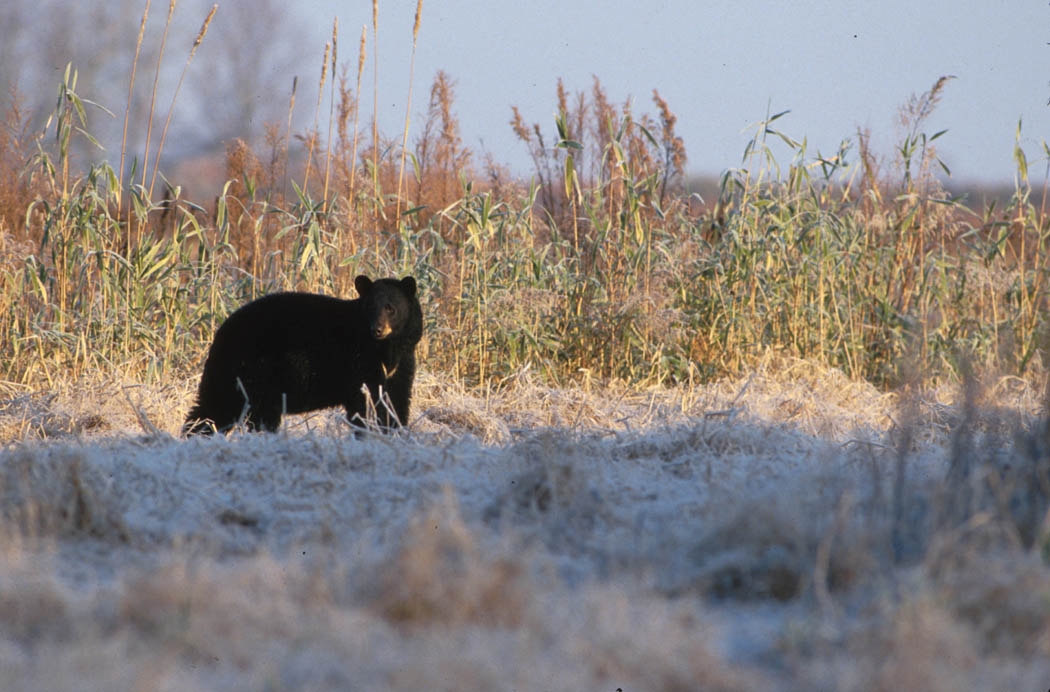 Ursus americanus or the American Black Bear American Black Bear is on the ODNR Endangered Specifies list. |
The bear is quite black, has short ears, a thick head and quite a sharp snout. It has but a very short tail and great strong claws on his feet. It can easily climb the trees and bring down chestnuts and acorns...They generally break off the branches, throw them down and then climb down to consume the nuts. Where there is food and mast they are found. It is as if they knew that in this or that region it would be good for them to live.
David Zeisberger's History of North American Indians, 1779-80.
Facts
<col width="30%" /> <col width="70%" />| Scientific Name: | Ursus americanus |
| Habitat: | Hardwood forests with occasional open areas (meadows). |
| Adult Weight: | 125 - 600 lbs. |
| Adult Body Length: | 2 to 3 feet |
| Birth Period: | mid-January - February |
| Litters Per Year: | 1 every other year |
| Litter Size: | 1 - 3, usually 2 |
| Life Expectancy: | up to 30 years |
| Foods: | Omnivore - eating berries, acorns, beechnuts, wild cherries, grass, herbs, insects, carrion, and fish. |
Notes
The Black Bear is the most common species of bear in the United States. Its name is confusing because it has many color phases, including black, brown and cinnamon.
Although the birth of cubs occurs in the winter, breeding usually occurs from mid-June to mid-July. The female bear (sow) is capable of delaying implantation of the eggs until December. The reason for this is unknown except that it gives the bears time to prepare for over-wintering and denning.
History
Prehistory
Black Bear remains have been found in prehistoric Indian mounds and other excavations throughout Ohio. Some of these date back to the early Archaic culture (8,000 BC - 6,000 BC). A carving of a Hopewell shaman dressed as a bear was found in a mound at the Newark Earthworks.
Pre-Settlement
Before settlement, Black Bears were common residents of Ohio's forests. Along with the white-tailed deer, the Black Bear was extremely important in the lives of American Indians. Besides its meat for food, the skins were used for sleeping skins, the teeth and claws decorations. The bear was also used for ceremonial purposes.
Shamans would sacrifice bear meat to the spirits of the dead.
Settlement
Black Bears were hunted heavily by settlers for meat, fat, and fur. Thousands of acres of forests were cleared for farming. In order to find food and living space, Black Bears began to leave Ohio.
Nineteenth Century
Extensive deforestation continued into the nineteenth-century. Any Black Bears that remained in the state were either shot or trapped in an attempt to protect crops and livestock. In The Pioneer of the Ohio Valley (Hildreth, 1848), it was written,
...one day during the year 1805, two children of John Spencer were playing in the yard of the cabin at the 'Big Spring' when a huge bear came along, seized a pig near them and made off with it. Had Bruin selected the youngest of those children instead of the pig, the career of the late Colonel William Spencer would have been cut short.
Black Bears were extirpated from Ohio by 1850.
Twentieth Century
Concerned by the disappearance of Black Bears throughout the Eastern United States, conservation began in the 1940s.
Sightings of Black Bear have been reported in 35 eastern Ohio counties since 1981 (annually since 1986). A formal Black Bear Reporting Procedure began in 1993 after there were 28 reports involving approximately 10 bears. In 1995, there were 48 reports on 21 bears. Most of these bears migrated from Pennsylvania and West Virginia, searched for food and then returned. However, from 1993-1995, reports included sows with cubs, showing a possible breeding population in Ohio. In 1999, the number of sightings increased to 56, representing perhaps 26 different bears.
The Ohio Department of Natural Resources is currently monitoring and studying the slowly recovering Black Bear. Black Bears are protected in Ohio and hunting them is prohibited.